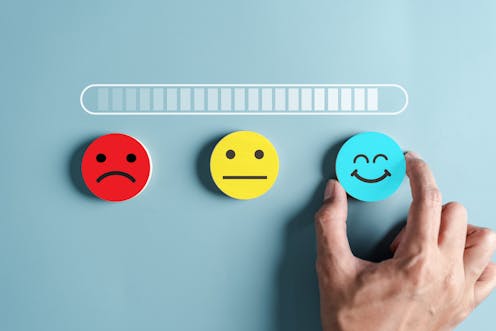
Menus are usually something you’d expect to come across in a restaurant. But one social media influencer went viral recently for sharing a different kind of menu – a “dopamine menu” or dopamenu.
The dopamine menu concept comes from a 2020 YouTube video by Jessica McCabe (How to ADHD). In her video, she suggests that dopamine menus are a tool that people with attention deficit hyperactivity disorder (ADHD) can use when they find they need stimulation – but may be at a loss for what to do. Each person can design their menu based on what they like, dividing it into appetisers, mains, sides and desserts.
Appetisers are activities that are quick to do and give immediate pleasure. Mains are activities that take longer to do, but are ultimately more rewarding. Sides can be paired with less enjoyable activities to make them more pleasurable. Desserts provide enjoyment, but should be taken in moderation.
The dopamine menu concept is based on the notion that people with ADHD have lower levels of dopamine (a neurotransmitter that plays a role in pleasure, learning and motivation) in their brains. As a result, they need more stimulation.
So, is there any scientific evidence to support the use of dopamine menus? Maybe – but to understand why, we must examine the brain reward pathway.
Brain reward pathway
The main pathway in the brain reward system is from the ventral tegmental area (VTA) to the nucleus accumbens, where dopamine is released. It’s hypothesised that evolutionary advantageous activities (such as sex, eating and socialising) cause activity in the VTA. This leads to an increase in dopamine levels in the accumbens, which makes us feel good.
Numerous activities can cause dopamine to be released – including many of those which are commonly included on dopamine menus, such as playing a board game or solving a puzzle, visiting with friends or family, playing an instrument or listening to a favourite song, cooking, baking or having a snack, exercising and trying something new.
But the amount of dopamine that’s released (and how sustained that release is) will depend on the activity. Some activities, such as running, can cause sustained low-level increases in dopamine for several hours. On the other hand, having a sugary drink, for example, leads to a high but only short-term increase in dopamine.
The frequency that we do certain activities in order to get bursts of dopamine can also work against us.

A good example of this can be found in rats, where we can measure dopamine levels directly in the accumbens. The first time a male rat meets with a female rat he gets a large burst of dopamine. But if you introduce another female rat shortly afterwards, it results in less dopamine. This phenomenon is called habituation or tolerance.
Similarly, illicit drugs (such as cocaine) that hijack the natural reward system can have large initial effects on dopamine. But rodent studies show that this effect is diminished the more often you use the drug. Tolerance to cocaine is also seen in humans.
This tolerance to short-acting rewards usually causes us to do one of two things: we move quickly on to a different activity to get a reward, or we do much more of the same activity to achieve the initial effect again.
Dopamine and ADHD
One popular hypothesis for ADHD is that it’s caused by a dysregulated dopamine system.
Dopamine levels in the brain come from “tonic” and “phasic” dopamine release. Tonic dopamine is the baseline level of dopamine that the resting dopamine neurons pump out.
But when something interesting happens to us or we do certain activities, we get a “phasic” (short, intense burst) of dopamine. This phasic release of dopamine is on top of the baseline tonic dopamine.
Dopamine levels in the brain are under a negative feedback mechanism, so when baseline levels are low, the phasic bursts tend to be higher. Conversely, when baseline levels are high (causing a lot of negative feedback) the phasic bursts are lower.
It’s hypothesised that people with ADHD have low background levels of dopamine. As a result, they continually seek the short-acting bursts of phasic dopamine, which are higher (and more rewarding) under these conditions. This is why drugs such as methylphenidate (Ritalin), which increase background levels of dopamine, work well for people with ADHD.
Brain imaging studies that differentiate between tonic and phasic dopamine levels confirm that people with ADHD have low levels of tonic dopamine at rest, and higher levels of phasic dopamine during a task that requires attention.
Taking the above information together, for someone with ADHD (who has reduced baseline dopamine), the best thing to include on a dopamine menu would be activities that provide sustained, low-level release of dopamine.
Examples of this might include doing some exercise, socialising or listening to music. Physical activity may be particularly beneficial in improving ADHD symptoms.
Activities involving novelty or having a sweet treat will do little to help people with ADHD as they only provide a short, sharp burst of dopamine – and we can quickly habituate to short-acting rewards.
Whether you have ADHD or not, engaging in healthy, long-acting pleasurable activities will invariably have a positive impact on health. So when it comes to dopamine menus, rather than having a three-course meal with sides and dessert, we suggest your menu should focus on healthy main courses that can give us a sustained boost in dopamine levels.
The authors do not work for, consult, own shares in or receive funding from any company or organisation that would benefit from this article, and have disclosed no relevant affiliations beyond their academic appointment.
This article was originally published on The Conversation. Read the original article.







